Il desiderio di andare oltre la contingenza, di dimenticare in qualche modo il concreto e a volte rude vivere contemporaneo induce molti artisti a trovare un linguaggio comunicativo che trascenda il visibile e si ponga in connessione con un’interiorità che non necessita di soffermarsi su un’esteriorità conosciuta; altri invece effettuano un percorso alla ricerca del senso metaforico, di un significato differente da ciò che lo sguardo scorge. E poi ve ne sono altri che invece si legano indissolubilmente a uno stile figurativo per compiere un percorso introspettivo e raccontare un mondo più elevato, più puro e affine a una morbidezza interiore che solo attraverso l’arte riesce a esprimersi. L’artista di cui vi parlerò oggi appartiene a quest’ultimo gruppo di creativi.
Nel corso dell’Ottocento dopo un periodo in cui predominò il Romanticismo con i suoi moti interiori, le connessioni tra natura ed essere umano, il suo voler riconciliarsi con il Divino abbandonandosi dopo la presa di coscienza della propria essenza effimera e temporanea e l’idealismo che portava a tendere verso un costante perfezionamento dello spirito, si affermò il Realismo, un movimento pittorico più legato al positivismo, pensiero filosofico che si basava su un’osservazione scientifica della realtà. Fu proprio grazie a questa corrente che grandi artisti come Gustave Courbet, con le sue scene di vita quotidiana di nobili o di contadini, o come Giuseppe Pelizza da Volpedo, con le sue immagini di rivolta dei lavoratori che cominciavano a reclamare più diritti, o ancora, per andare oltreoceano, con il Muralismo messicano di cui fu capostipite Diego Rivera, che è ancora oggi possibile avere testimonianze sostanziali della vita dell’epoca e del lungo cammino intrapreso per giungere ai diritti di cui si gode nella società attuale, oltre alla meraviglia di trovarsi davanti a opere d’arte di incredibile perfezione esecutiva. Nel corso del Novecento però il Realismo ha subìto una trasformazione divenendo via via mezzo più introspettivo, più orientato a osservare, comprendere e interpretare piuttosto che denunciare o portare alla luce condizioni di vita e lavorative contingenti e non partecipate dall’artista, assumendo così un approccio più soggettivo, più esistenziale, che non semplicemente di attenzione oggettiva. Edward Hopper ha declinato l’osservazione della realtà sottolineando il senso di solitudine, di immobilità dell’essere umano intrappolato nelle pieghe di un’esistenza incapace di farlo sentire davvero vivo, tanto quanto Antonio Donghi e Felice Casorati hanno raffigurato l’uomo e la donna in una dimensione magica, come se fossero in stretta connessione con l’ambiente circostante malgrado la loro inconsapevolezza di tale contatto, per passare alla morbidezza delle sensazioni, dei ricordi e delle ambientazioni di Jack Vettriano, i cui protagonisti si muovono tra sentimento e sensualità, tra eleganza e passioni in grado di avvolgere l’osservatore in virtù della sensibilità di osservazione dell’artista. La tedesca Waltraud Fall, da sempre incline alla manifestazione creativa a cui però, per scelta di vita, rinuncia per molti anni, ha bisogno del Realismo per raccontare la realtà dal suo punto di vista, con uno sguardo delicato e carezzevole attraverso il quale esprime il suo tendere verso un mondo ideale, fatto di semplicità, di emozioni silenziose, di ritorno a una naturalezza troppo spesso accantonata nel vivere contemporaneo.

La predilezione per oggetti comuni e fiori, è evidentemente un modo per ricordare a se stessa, e di conseguenza all’osservatore, quanta poesia e quanti accordi melodici si nascondono dentro tutto ciò su cui lo sguardo si sofferma raramente, effettuando un passaggio distratto per poi concentrarsi sul materialismo, sugli impegni a cui far fronte nel corso delle complesse e piene giornate.
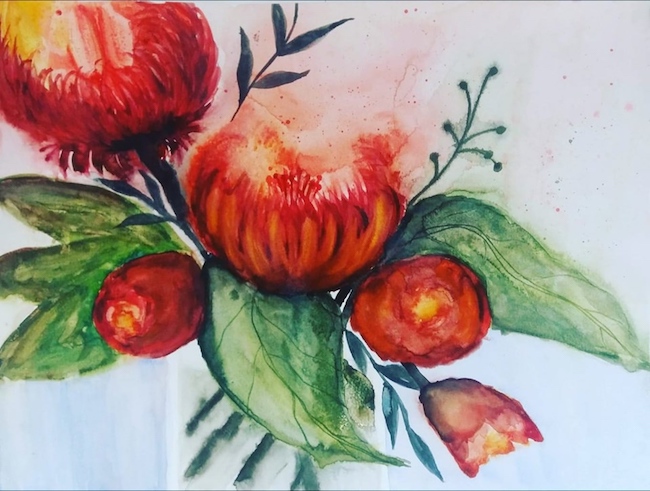
Waltraud Fall invece si perde all’interno della bellezza della semplicità, di quella leggerezza intorno a sé in grado di trasportare il pensiero verso un modo di vivere forse antico, lontano dalla contingenza attuale, eppure forse l’unico in grado di permettere all’essere umano di restare in contatto con la propria vera essenza, con quell’interiorità che necessita di esprimersi, di fuoriuscire e di liberarsi senza la necessità di difendersi dall’esterno, di proteggersi dal potenziale rischio di essere ferita. Non vi è uno studio della realtà circostante nelle opere della Fall, non vuole andare a indagare e portare alla luce le dinamiche complesse della società esterna, bensì emerge un contatto profondo con l’anima, un atteggiamento di esplorazione di un sentire che non può fare a meno di connettersi con ciò che la circonda secondo un livello di ascolto superiore, un’interazione con le energie sottili che avvolgono ogni essere animato e inanimato.
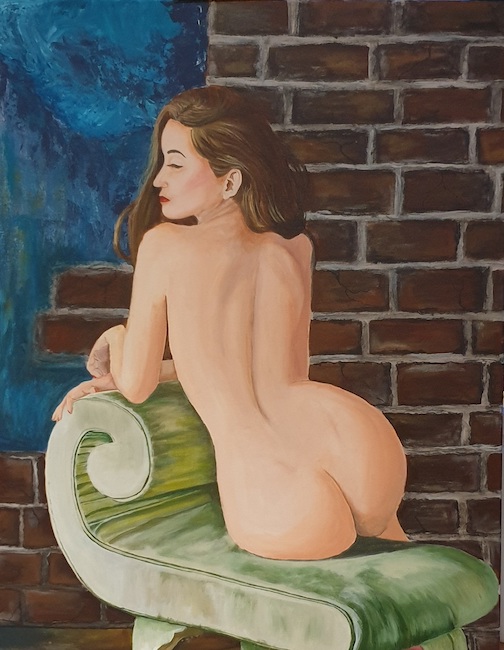
Proprio in virtù di questa esigenza di ascoltare il mondo intorno a sé, molto spesso i suoi dipinti assumono un’accezione esplorativa che si avvicina alla Metafisica, avvolgendo ciò che viene osservato di un significato più intenso, di un enigma che si cela oltre il visibile e che viene indagato dall’artista attraverso una sensibilità che le consente di mettere in evidenza proprio quel mistero che è al di là di oggetti quotidiani, quell’interazione che li rende trascurabili eppure indispensabili per rassicurare l’individuo.
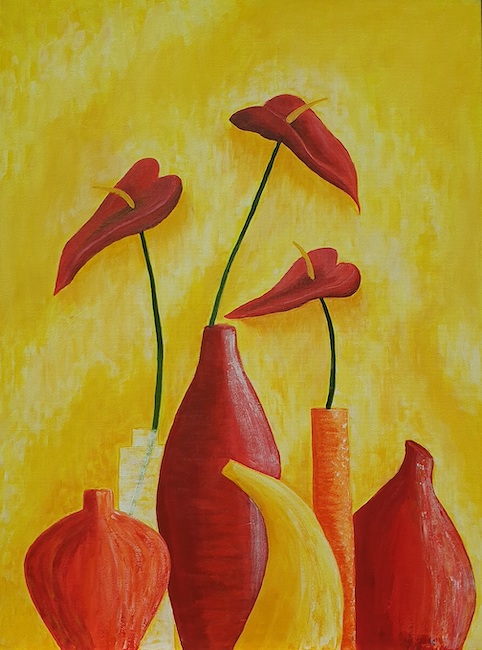
L’opera Anthurien (Anturia) mostra quanto l’interconnessione e l’armonia siano importanti nella produzione artistica della Fall, come se la differenza tra esseri animati e oggetti fosse superato da un’energia che tutto collega, che tutto indissolubilmente unisce e che non può fare a meno di essere colta da uno sguardo attento e curioso; il tratto realista in quest’opera diviene essenziale, al punto di tendere verso una stilizzazione Minimalista avvolta dall’enigma immobile della Metafisica, mostrando l’abilità dell’artista ne creare equilibrio visivo che riesce a far vibrare le corde emotive dell’osservatore.
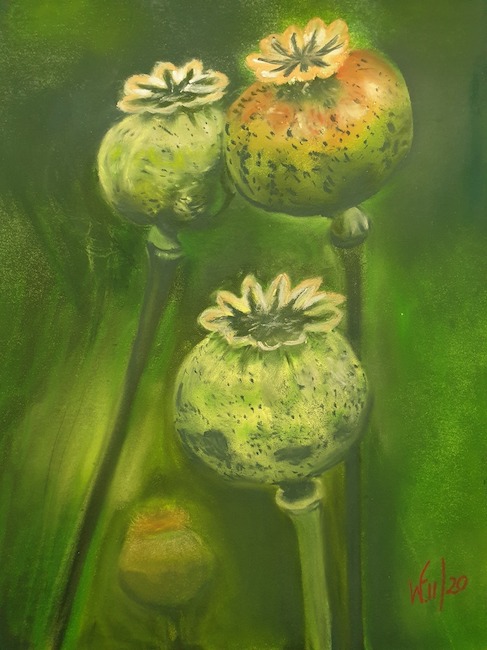
L’oggetto si fonde alla natura con un tocco pittorico sognante, in cui le tonalità del contesto circostante si accordano a quelle dei soggetti raffigurati in primo piano, come nella tela Mohnkapseln (Capsule di Papavero), in un accordo melodico nel quale l’apparenza si connette con l’essenza, con una sostanza attraverso la quale viene manifestata la sensazione che l’artista riceve quando si appresta a dipingere. In altre opere invece lo sfondo diviene mezzo per porre in evidenza l’immagine protagonista, confermando così l’intensità di un solo oggetto apparentemente senza importanza che però assume una rilevanza decisamente maggiore nel momento in cui viene osservato come se si trovasse sotto una luce teatrale che ne evidenzia il protagonismo. Il desiderio espressivo della Fall non si limita però alle nature morte bensì si amplia al corpo femminile inteso come manifestazione di un’interiorità che si libera solo nella fase di solitudine, quando il silenzio consente alle protagoniste di svelarsi, di mettersi a nudo, e di approfondire il vissuto attraverso un percorso introspettivo fondamentale a osservare e comprendere gli eventi e le dinamiche di quanto accaduto.
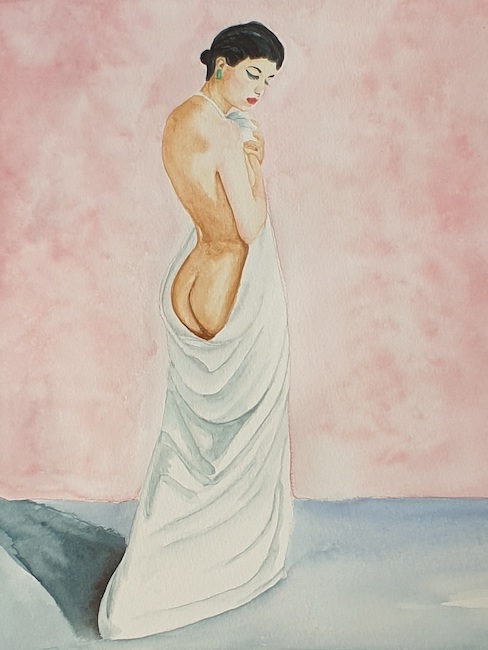
La tela Zerbrechlichkeit (Fragilità) è simbolica proprio di questo concetto perché la donna in primo piano e di spalle rispetto al punto di osservazione, sembra volersi proteggere dall’esterno pur nella consapevolezza di aver bisogno di lasciar fuoriuscire quei dubbi, quelle insicurezze che appartengono alla sua natura tanto quanto al percorso della vita che sta affrontando.
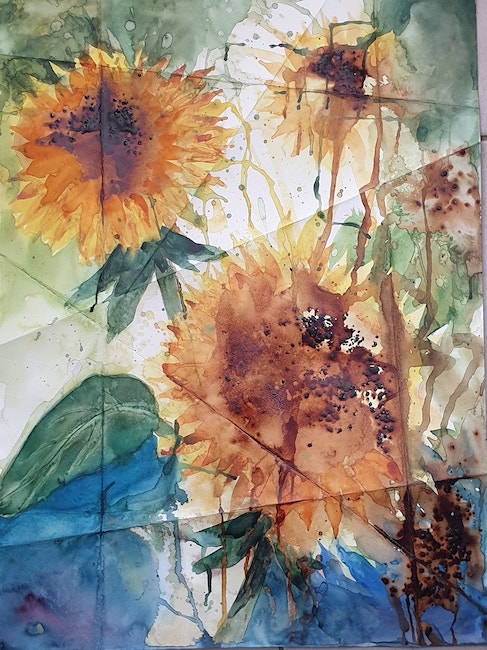
Sperimenta differenti tecniche pittoriche Waltraud Fall, passa dall’acquarello alla gouache, dall’olio all’acrilico, dal gesso al pastello per non arginare l’esigenza di liberare le proprie sensazioni limitandole a un solo linguaggio espressivo; nel corso degli anni l’artista ha prodotto molte tele senza tuttavia esporle, forse per un bisogno di viversi la propria esperienza evolutiva nell’interiorità del suo studio o forse perché non si sentiva pronta a mostrare la propria essenza pubblicamente. Ora però si sente pronta a confrontarsi con il mondo esterno e a farsi conoscere da collezionisti ed esperti del settore.
WALTRAUD FALL-CONTATTI
Email: waltraudfall@web.de
Sito web: https://kunst-fall.menschkunst.de
Facebook: https://www.facebook.com/MalenmachtFreude
Instagram: https://www.instagram.com/waltraud_fall_art/
Waltraud Fall, when Realism becomes a means of revealing the delicacy of the soul
The desire to go beyond the contingent, to somehow forget the concrete and at times rough contemporary life leads many artists to find a communicative language that transcends the visible and connects with an interiority that does not need to dwell on a known exterior; others instead follow a path in search of a metaphorical sense, of a meaning different from what the eye sees. And then there are others who are inextricably linked to a figurative style in order to make an introspective journey and recount a higher, purer world, a world akin to an inner softness that can only be expressed through art. The artist I am going to talk about today belongs to the latter group of creatives.
During the nineteenth century, after a period in which Romanticism predominated with its inner movements, its connections between nature and the human being, its desire to be reconciled with the Divine by abandoning itself after becoming aware of its ephemeral and temporary essence and the idealism that led to a tendency towards constant improvement of the spirit, emerged Realism, a pictorial movement more closely linked to positivism, a philosophical thought based on a scientific observation of reality. It was thanks to this current that great artists such as Gustave Courbet, with his scenes of everyday life of nobles or peasants, or Giuseppe Pelizza da Volpedo, with his images of revolts of the workers that were beginning to demand more rights, or, to go overseas, with Mexican Muralism, of which Diego Rivera was the founder, it is still possible to have substantial evidence of the life of the time and the long road taken to achieve the rights enjoyed in today’s society, as well as the wonder of being in front of artworks of incredible executive perfection.
In the course of the twentieth century, however, Realism underwent a transformation, gradually becoming more introspective, more oriented towards observing, understanding and interpreting rather than denouncing or bringing to light contingent living and working conditions that the artist did not participate in, thus taking on a more subjective, existential approach rather than simply that of objective attention. Edward Hopper declined the observation of reality by emphasising the sense of solitude, of immobility of the human being trapped in the folds of an existence incapable of making him feel truly alive, just as Antonio Donghi and Felice Casorati depicted man and woman in a magical dimension, as if they were in close connection with their surroundings despite their unawareness of such contact, to move on to the softness of sensations, memories and settings of Jack Vettriano, whose protagonists move between sentiment and sensuality, between elegance and passions capable of enveloping the observer by virtue of the artist’s sensitivity of observation. The German artist Waltraud Fall, who has always been inclined towards creative expression but renounced it for many years due to her life choice, needs Realism to tell reality from her point of view, with a delicate and caressing gaze through which she expresses her tendency towards an ideal world, made of simplicity, silent emotions, a return to a naturalness that is too often set aside in contemporary life. Her predilection for common objects and flowers is clearly a way of reminding herself, and consequently the observer, how much poetry and how many melodic chords are hidden within everything that the eye rarely lingers on, making a distracted pass to then focus on materialism, on the commitments to be faced in the course of the complex and busy days. Waltraud Fall, on the other hand, loses herself in the beauty of simplicity, of that lightness around her that is capable of transporting thought towards a way of life that is perhaps ancient, far from the current contingency, yet perhaps the only one capable of allowing human beings to remain in contact with their true essence, with that interiority that needs to express itself, to escape and free without the need to defend from the outside, to protect from the potential risk of being wounded.
There is no study of the surrounding reality in Fall’s artworks, she does not want to investigate and bring to light the complex dynamics of external society, but rather emerges a deep contact with the soul, an attitude of exploration of a feeling that cannot help but connect with what surrounds it according to a higher level of listening, an interaction with the subtle energies that envelop every animate and inanimate being. Precisely because of this need to listen to the world around her, her paintings very often take on an exploratory meaning that comes close to Metaphysics, enveloping what is observed with a more intense meaning, with an enigma that is hidden beyond the visible and that is investigated by the artist through a sensitivity that enables her to highlight precisely that mystery that lies beyond everyday objects, an interaction that makes them negligible yet indispensable for reassuring the individual. The painting Anthurien shows how important interconnection and harmony are in Fall’s artistic production, as if the difference between animate beings and objects were overcome by an energy that connects everything, that indissolubly unites everything and that cannot fail to be grasped by an attentive and curious gaze; in this artwork, the realistic line becomes essential, to the point of tending towards a Minimalist stylisation wrapped in the immobile enigma of Metaphysics, showing the artist’s ability to create a visual balance that manages to make the observer’s emotional chords vibrate.
The object blends into nature with a dreamy pictorial touch, in which the tones of the surrounding context match those of the subjects depicted in the foreground, as in the canvas Mohnkapseln (Poppy Capsules), in a melodic chord in which appearance connects with essence, with a substance through which the sensation the artist receives when she paints is manifested. In other artworks, however, the background becomes a means of highlighting the protagonist image, thus confirming the intensity of a single, apparently unimportant object which, however, takes on much greater importance when observed as if it were under a theatrical light that highlights its protagonism. Fall’s expressive desire is not limited to still lifes, however, but extends to the female body, understood as the manifestation of an interiority that is only released in the phase of solitude, when silence allows the protagonists to reveal, to lay themselves bare, and to deepen their experience through an introspective path that is fundamental for observing and understanding the events and dynamics of what has happened. The canvas Zerbrechlichkeit (Fragility) is symbolic of this very concept because the woman in the foreground, with her back to the point of observation, seems to want to protect herself from the outside world even though she is aware of the need to let out those doubts and insecurities that belong to her nature as much as to the path of life she is facing. Waltraud Fall experiments with different painting techniques, moving from watercolour to gouache, from oil to acrylic, from chalk to pastel so as not to curb the need to free her feelings by limiting them to a single expressive language; over the years the artist has produced many canvases without exhibiting them, perhaps out of a need to live her own evolutionary experience in the interior of her studio or perhaps because she did not feel ready to show her essence publicly. Now, however, she feels ready to face the outside world and make herself known to collectors and experts in the field.














